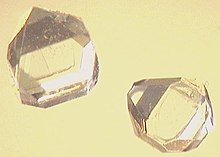I also looked it up on Wikipedia too and here is what they have to say;
Xylitol
| Xylitol[1] | |
|---|---|
 | |
| (2R,3r,4S)-Pentane-1,2,3,4,5-pentol | |
| Other names 1,2,3,4,5-Pentahydroxypentane; Xylite | |
| Identifiers | |
| CAS number | 87-99-0 |
| ChEMBL | CHEMBL96783 |
| Properties | |
| Molecular formula | C5H12O5 |
| Molar mass | 152.15 g mol−1 |
| Density | 1.52 g/cm³ |
| Melting point | 92-96 °C |
| Boiling point | 216 °C |
| Related compounds | |
| Related alkanes | Pentane |
| Except where noted otherwise, data are given for materials in their standard state (at 25 °C, 100 kPa) | |
| Infobox references | |
Xylitol (from Greek ξύλον - xyl[on], "wood" + suffix -itol, used to denote sugar alcohols) is a sugar alcohol sweetener used as a naturally occurring sugar substitute. It is found in the fibers of many fruits and vegetables, including various berries, corn husks, oats, and mushrooms.[2] It can be extracted from corn fiber,[3] birch, raspberries, plums, and corn. Xylitol is roughly as sweet as sucrose with only two-thirds the food energy.
As with other sugar alcohols, with the exception of erythritol, consumption in excess of one's laxation threshold (the amount of sweetener that can be consumed before abdominal discomfort sets in) can result in temporary gastrointestinal side effects, such as bloating and diarrhea. Adaptation, an increase of the laxation threshold, occurs with regular intake. Xylitol has a lower laxation threshold than some sugar alcohols, but is more easily tolerated than others such as mannitol and sorbitol.[4][5]
Xylitol is an organic compound with the formula (CHOH)3(CH2OH)2. This achiral species is one of four isomers of 1,2,3,4,5-pentapentanol.
So in conclusion I think it is safe to use in small amounts and if you don't want to try or have unpleasant symptoms change it in my recipes for Agave Nectar, Stevia, or Sugar Cane.

No comments:
Post a Comment